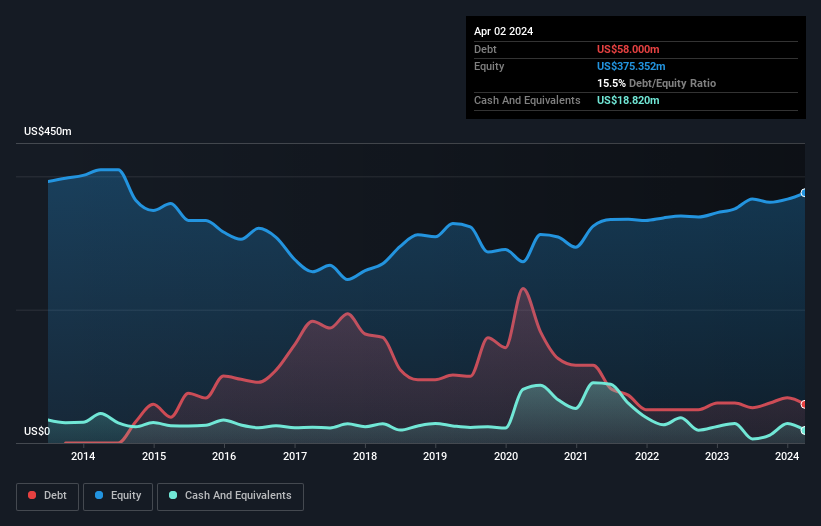- United States
- /
- Hospitality
- /
- NasdaqGS:BJRI
BJ's Restaurants (NASDAQ:BJRI) Takes On Some Risk With Its Use Of Debt
Some say volatility, rather than debt, is the best way to think about risk as an investor, but Warren Buffett famously said that 'Volatility is far from synonymous with risk.' It's only natural to consider a company's balance sheet when you examine how risky it is, since debt is often involved when a business collapses. Importantly, BJ's Restaurants, Inc. (NASDAQ:BJRI) does carry debt. But should shareholders be worried about its use of debt?
What Risk Does Debt Bring?
Debt assists a business until the business has trouble paying it off, either with new capital or with free cash flow. Part and parcel of capitalism is the process of 'creative destruction' where failed businesses are mercilessly liquidated by their bankers. While that is not too common, we often do see indebted companies permanently diluting shareholders because lenders force them to raise capital at a distressed price. Of course, plenty of companies use debt to fund growth, without any negative consequences. When we examine debt levels, we first consider both cash and debt levels, together.
View our latest analysis for BJ's Restaurants
What Is BJ's Restaurants's Debt?
As you can see below, BJ's Restaurants had US$58.0m of debt, at April 2024, which is about the same as the year before. You can click the chart for greater detail. However, it does have US$18.8m in cash offsetting this, leading to net debt of about US$39.2m.

How Healthy Is BJ's Restaurants' Balance Sheet?
According to the last reported balance sheet, BJ's Restaurants had liabilities of US$186.6m due within 12 months, and liabilities of US$483.0m due beyond 12 months. On the other hand, it had cash of US$18.8m and US$15.2m worth of receivables due within a year. So it has liabilities totalling US$635.6m more than its cash and near-term receivables, combined.
This deficit is considerable relative to its market capitalization of US$820.0m, so it does suggest shareholders should keep an eye on BJ's Restaurants' use of debt. Should its lenders demand that it shore up the balance sheet, shareholders would likely face severe dilution.
We measure a company's debt load relative to its earnings power by looking at its net debt divided by its earnings before interest, tax, depreciation, and amortization (EBITDA) and by calculating how easily its earnings before interest and tax (EBIT) cover its interest expense (interest cover). Thus we consider debt relative to earnings both with and without depreciation and amortization expenses.
Looking at its net debt to EBITDA of 0.40 and interest cover of 5.0 times, it seems to us that BJ's Restaurants is probably using debt in a pretty reasonable way. So we'd recommend keeping a close eye on the impact financing costs are having on the business. Pleasingly, BJ's Restaurants is growing its EBIT faster than former Australian PM Bob Hawke downs a yard glass, boasting a 177% gain in the last twelve months. The balance sheet is clearly the area to focus on when you are analysing debt. But ultimately the future profitability of the business will decide if BJ's Restaurants can strengthen its balance sheet over time. So if you're focused on the future you can check out this free report showing analyst profit forecasts.
Finally, a company can only pay off debt with cold hard cash, not accounting profits. So we always check how much of that EBIT is translated into free cash flow. During the last two years, BJ's Restaurants burned a lot of cash. While that may be a result of expenditure for growth, it does make the debt far more risky.
Our View
We feel some trepidation about BJ's Restaurants's difficulty conversion of EBIT to free cash flow, but we've got positives to focus on, too. To wit both its EBIT growth rate and net debt to EBITDA were encouraging signs. We think that BJ's Restaurants's debt does make it a bit risky, after considering the aforementioned data points together. That's not necessarily a bad thing, since leverage can boost returns on equity, but it is something to be aware of. When analysing debt levels, the balance sheet is the obvious place to start. However, not all investment risk resides within the balance sheet - far from it. For example, we've discovered 2 warning signs for BJ's Restaurants that you should be aware of before investing here.
When all is said and done, sometimes its easier to focus on companies that don't even need debt. Readers can access a list of growth stocks with zero net debt 100% free, right now.
Valuation is complex, but we're here to simplify it.
Discover if BJ's Restaurants might be undervalued or overvalued with our detailed analysis, featuring fair value estimates, potential risks, dividends, insider trades, and its financial condition.
Access Free AnalysisHave feedback on this article? Concerned about the content? Get in touch with us directly. Alternatively, email editorial-team (at) simplywallst.com.
This article by Simply Wall St is general in nature. We provide commentary based on historical data and analyst forecasts only using an unbiased methodology and our articles are not intended to be financial advice. It does not constitute a recommendation to buy or sell any stock, and does not take account of your objectives, or your financial situation. We aim to bring you long-term focused analysis driven by fundamental data. Note that our analysis may not factor in the latest price-sensitive company announcements or qualitative material. Simply Wall St has no position in any stocks mentioned.
About NasdaqGS:BJRI
Adequate balance sheet with moderate growth potential.
Market Insights
Community Narratives



